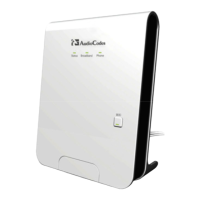User's Manual 11. Quality of Service
Version 4.4.0 137 MP26x/MP27x
11.2 Configuring Traffic Shaping
Traffic Shaping is the solution for managing and avoiding congestion where a high speed
LAN meets limited broadband bandwidth. A user may have, for example, a 100 Mbps
Ethernet LAN with a 100 Mbps WAN interface router. The router may communicate with
the ISP using a modem with a bandwidth of 2 Mbps. This typical setup makes the modem,
having no QoS module, the bottleneck. The router sends traffic as fast as it is received,
while its well-designed QoS algorithms are left unused. Traffic shaping limits the bandwidth
of the router, artificially forcing the router to be the bottleneck.
A traffic shaper is essentially a regulated queue that accepts uneven and/or bursty flows of
packets and transmits them in a steady, predictable stream so that the network is not
overwhelmed with traffic.
While Traffic Priority allows basic prioritization of packets, Traffic Shaping provides more
sophisticated definitions such as:
Bandwidth limit for each device
Bandwidth limit for classes of rules
Prioritization policy
TCP serialization on a device
You can also define QoS traffic shaping rules for a default device. These rules are used on
a device that has no definitions of its own. This enables the definition of QoS rules on
Default WAN, for example, and their maintenance even if the PPP or bridge device over
the WAN is removed.
The device also supports dynamic traffic shaping during a call. Traffic shaping is critical in
residential VoIP gateways because of the bottleneck created in the xDSL or Cable modem,
mainly in the upload direction. Dynamic traffic shaping ensures a minimum bandwidth for
VoIP calls. Without dynamic traffic shaping, traffic shaping limits the bandwidth at all times,
even if the user is not making a VoIP call and therefore, the service provider needs to
configure the QoS traffic shaping transmit (Tx) bandwidth according to the user's specific
upload bandwidth. Configuring a lower value results in a lower upload bandwidth (not only
during VoIP calls).
Dynamic traffic shaping enables the service provider to configure two upload traffic shaping
bandwidth parameters:
"Tx Bandwidth" - for all traffic
"Tx Bandwidth during Call" - for VoIP calls
The device normally uses the "Tx Bandwidth" value. When the user makes a VoIP call (i.e.
any phone/s connected to the device is ringing or off-hook), the device switches to use the
"Tx Bandwidth during Call" value.

